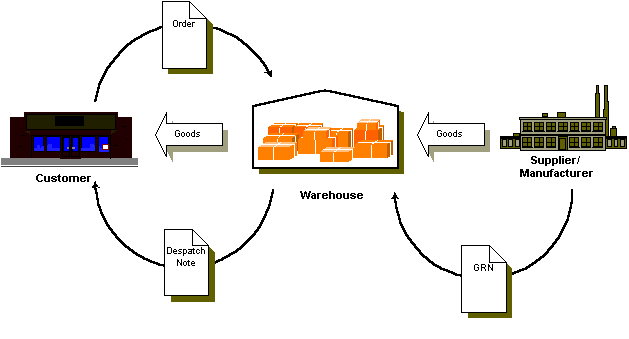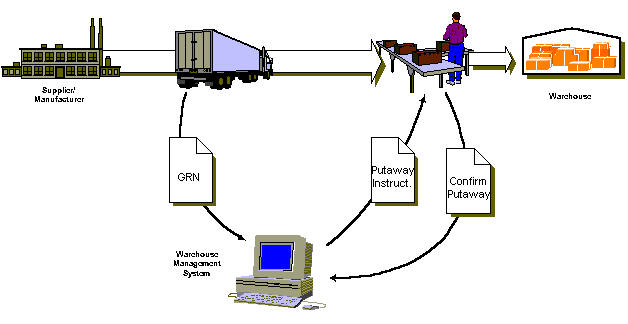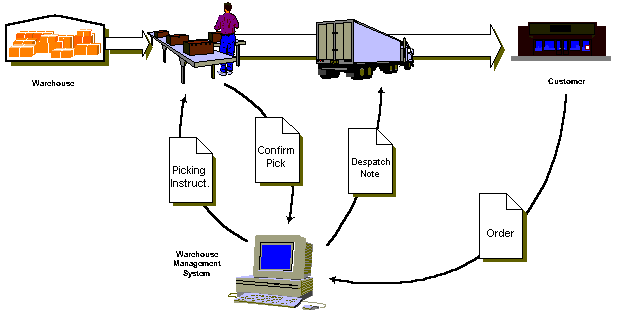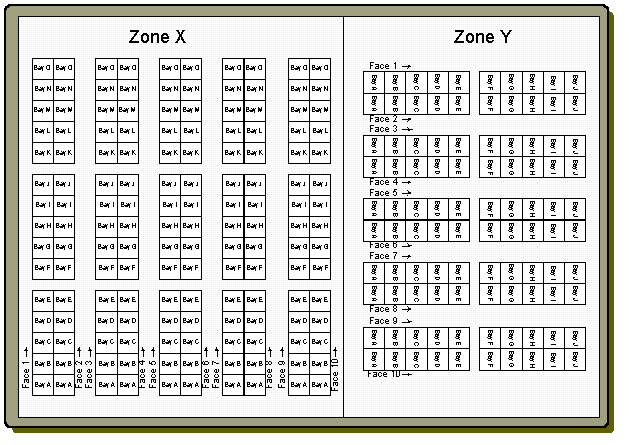The Xe-WMS Apparel Warehouse and Distribution Management System - an Overview |
 Home Home
|
The XeBusiness Warehouse and Distribution software package is capable of controlling warehouses of all sizes. It is fully integrated with EDI and data can be captured by hand held laser scanning devices linked to the database by either fixed docking stations or RF (Radio Frequency) transmissions.
Overall system diagram

|
| ||
Goods Received

|
| ||
Order Processing/Goods Out

|
| ||
Locations
A fundamental concept in The Warehouse Management System is the Location - the place items are stored. As the Xe-WMS Apparel Software System is a generic system, it must provide flexibility to cope with any type of warehouse and any type of stock. In order to provide such flexibility, the following conceptual areas within the warehouse are used:
Example Warehouse - top view

|
A zone is the largest area within a warehouse. In some warehouses, especially small warehouses, there may be only one zone whereas in other, possibly larger warehouses there may be several zones. You can use zones to separate different departments: you may like to have different zones for departments T01 and T02, for instance. You can also use zones to represent different physical locations within your warehouse: you may have a zone for downstairs and a zone for upstairs. When The Warehouse Management System is installed at your site, a survey will have already been carried out to determine the best system for your needs.
A face represents a picking face: the aisle you walk down when picking goods from a particular bay. Faces generally run parallel to each other.
In order to arrive at a particular bay, you must therefore specify a zone, a face and a bay number.
A bay is a vertical multi-level collection of locations. One level within a bay represents the smallest area within a warehouse: a single unique location. A location can store any type of item and could be a pallet, a clothes rail, a bin or even simply floor space.
Therefore, to identify a single unique location within your entire warehouse, you must specify the zone, the face, the bay and the level.
This system ensures that The Warehouse Management System is able to work with practically any warehouse configuration. Under some circumstances, however, Xe-WMS Apparel Software System may have been tailored further to accommodate an unusual situation.
The functional components of the system are as follows:
Warehouse locations are defined as a number of zones, faces, bays and levels. Each location has a rail height (to restrict the types of products placed in the location) and a rail length (to define the maximum number of garments placed in to location).
Product definition covering products that are defined as a combination of department and stroke. Each product can be classified over a variety of colour, size and length combinations. Each product also has a set size (for determining despatch labels), a number per metre (for determining maximum number of garments per location), a preferred 'putaway' location (used for picking and putaway algorithms) and where appropriate, a product height for restricting storage locations. Each product variant is also identified with a UPC (unique product code).
Stock details are held at location level, with products in each location being identified by their product definitions (see above) together with a supplier series number (for third party distributors) identifying the supplier of the product.
Quantities of stock in these locations can be marked as 'quarantined' or 'export reserved', which will prevent the product from being picked unless overridden.
Audit trails are extremely comprehensive and log all stock transfers with an electronic date, time, initiator and reference stamp. This transaction information is archived for the life of the product and can be easily and flexibly accessed for management information reporting purposes.
Customer/Retailer orders and call offs can either be directly transferred from an EDI system or entered via a computer terminal. The system comes with a wide-ranging series of reports and enquiries geared to highlighting exceptions (e.g.; shortages).
Picking instructions can be generated from customer orders, allowing selection of specific customer depot destinations and order references, utilising parameters like picking algorithms that can be customised to reflect the user's warehousing environment. Picking instructions produced by the system (available in both summary and/or in detail form) are passed to warehouse staff to pick the required products and then returned (with annotations) to the system for confirmation entry.
Despatch documentation (consignment notes and bar coded despatch labels) is automatically produced and audit trails are available for electronic archiving or for hard copy printing. A delivery advice EDI message can also be automatically sent to the customer to facilitate receipt into stock at the store or customer warehouse. Bar coded labels produced by the system and affixed to consignments, also facilitate fast and accurate recording into stock at the customer end.
Goods receipts are entered by quantity and a unique 'putaway' algorithm is employed by the system to determine an 'ideal' location for the products in terms of optimal access for despatch later. The 'putaway' algorithm can be manually overridden to provide additional flexibility. Other features of the system allow stock adjustment, stock movements, export, stock allocations, quality assurance returns, and quarantined stocks to be processed within a comprehensive security and audit trail framework.
Management information availability was a major design criterion for the system from the outset. A large number of reports (geared to highlighting exceptions) are available as standard and a generic report writer is also available for use by users to produce customised reports and enquiries.
An integration mapper is available as standard, to quickly link (if required) the system to other software applications, modellers, databases and word processors. Whereas the system was originally developed to handle hanging goods, it can also be quickly adapted to warehouse operations that manage boxed goods.
Scanner Input/Output can be used to process all transactions. By making use of the bar-coded POS labels which are already attached to garments as they arrive from the Supplier, receipts, putaways and despatches can all be processed remotely by scanner, without tedious keyboard entry.